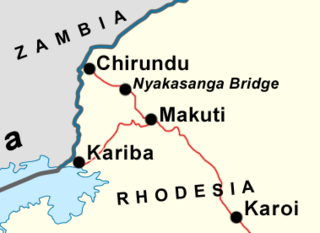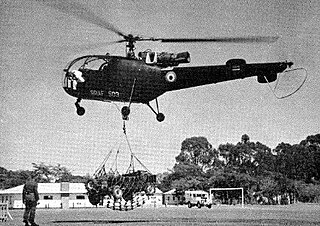
The Rhodesian African Rifles (RAR) was a regiment of the Rhodesian Army. The ranks of the RAR were recruited from the black African population, although officers were generally from the white population. The regiment was formed in May 1940 in the British colony of Southern Rhodesia.

The 1st Battalion, Rhodesian Light Infantry (1RLI), commonly The Rhodesian Light Infantry (RLI), was a regiment formed in 1961 at Brady Barracks as a light infantry unit within the army of the Federation of Rhodesia and Nyasaland. Barely a year after its creation, it was relocated to Cranborne Barracks (Salisbury) where its headquarters remained for the rest of its existence. The Regiment became part of the Southern Rhodesian Army when the Federation dissolved at the start of 1964 and, later that year, reformed into a commando battalion.

The Rhodesian Security Forces were the military forces of the Rhodesian government. The Rhodesian Security Forces consisted of a ground force, the Rhodesian Air Force, the British South Africa Police, and various personnel affiliated to the Rhodesian Ministry of Internal Affairs. Despite the impact of economic and diplomatic sanctions, Rhodesia was able to develop and maintain a potent and professional military capability.

The 1st Battalion, The Rhodesian Light Infantry, commonly the Rhodesian Light Infantry, was originally formed in 1961 as a regiment of the army of the Federation of Rhodesia and Nyasaland. Raised as a light infantry unit at Brady Barracks, Bulawayo in Southern Rhodesia, the Regiment served in the Rhodesian Bush War as part of the Rhodesian Security Forces between 1964 and 1979, from 1965 under the unrecognised governments of Rhodesia and latterly, during the second half of 1979, Zimbabwe Rhodesia. The RLI remained active during an interim period under British control and then, from April 1980, within the armed forces of Zimbabwe, before disbanding on 31 October 1980.

The 1st Battalion, The Rhodesian Light Infantry, commonly the Rhodesian Light Infantry, served in the Rhodesian Bush War as part of the Rhodesian Security Forces between 1964 and 1979, under the unrecognised government of Rhodesia following its 1965 Unilateral Declaration of Independence from Britain. During the second half of 1979 it fought for Zimbabwe Rhodesia, a black majority-ruled version of the same state which also failed to win international recognition. After an interim period under British control from December 1979 to April 1980, the RLI briefly remained active within the armed forces of Zimbabwe, but did not see action under this government. It disbanded on 31 October 1980.
The 1st Battalion, The Rhodesian Light Infantry, commonly the Rhodesian Light Infantry, served in the Rhodesian Bush War as part of the Rhodesian Security Forces between 1964 and 1979, under the unrecognised government of Rhodesia after its Unilateral Declaration of Independence from Britain on 11 November 1965. Latterly, during the second half of 1979, it fought for Zimbabwe Rhodesia, a reorganised version of Rhodesia under a black majority government which still went unrecognised. After an interim period under British control from December 1979 to April 1980, the RLI briefly remained active within the armed forces of the internationally recognised Republic of Zimbabwe, but did not see action under this government. It laid up its colours on 17 October 1980 and disbanded two weeks later.

7 Independent Company was a short-lived company of francophone volunteers in the Rhodesian Army during the Rhodesian Bush War. Numbering about 200 men at its peak, it was unique in the history of the Rhodesian Army as an exclusively expatriate unit. It existed between November 1977 and May 1978 as a company in the 1st Battalion, the Rhodesia Regiment, and served two counter-insurgency tours on Operation Hurricane in north-eastern Rhodesia.

Southern Rhodesia, then a self-governing colony of the United Kingdom, sent two military units to fight with the Commonwealth armed forces in the Malayan Emergency of 1948–60, which pitted the Commonwealth against the Malayan National Liberation Army (MNLA), the military arm of the Malayan Communist Party. For two years, starting in March 1951, white Southern Rhodesian volunteers made up "C" Squadron of the Special Air Service (SAS). The Rhodesian African Rifles, in which black rank-and-filers and warrant officers were led by white officers, then served in Malaya from 1956 to 1958.
The Battle of Sinoia, also known as the Battle of Chinhoyi was a small military engagement fought near Sinoia between a small unit of Zimbabwe African National Liberation Army (ZANLA) guerrillas and the Rhodesian police force on 28 April 1966. The skirmish is generally considered the opening engagement of the Rhodesian Bush War A team of seven ZANLA cadres engaged with British South Africa Police forces near the northern town of Sinoia. The seven guerrillas all eventually died in the battle, the police killing all seven.
The attack on Altena Farm occurred in the early hours of 21 December 1972, during the third phase of the Rhodesian Bush War. Altena was a tobacco farm owned by Marc de Borchgrave, a white Rhodesian landowner who was unpopular among the local civilians. Some sources have indicated that this marked the beginning of the conflict proper, despite the minor threat already represented by guerrilla movements in Rhodesia in the late 1960s.

Operation Yodel was an operation launched by the Rhodesian Security Forces on 13 September 1966 in response to an attack on civilians executed by communist insurgents who crossed over the border from Zambia into Rhodesia.
The Battle of Hill 31 took place between the Rhodesian security forces and ZANU insurgents- who had crossed the Rhodesian border with Mozambique on 15 November 1976.
Operation Flotilla was a military operation launched by the Rhodesian Army working with the Portuguese Army in Mozambique in response to the threat posed to Rhodesia by a group of 17 Lusaka-based nationalists who had the intent of entering Rhodesia through its border with Mozambique.
Operation Nickel or the Wankie Campaign or the Wankie Battles was a military operation launched by the Rhodesian Security Forces on 1 August 1967 in response to the group of ZIPRA and Umkhonto we Sizwe (MK) fighters crossing the Zambezi River, which marked the Rhodesian-Zambian border. The operation was a success with only one of the cadres out of a force of seventy-nine making it back to Zambia.
Operation Cauldron was launched by the Rhodesian Security Forces in response to an incursion by ZIPRA insurgents on 28 December 1967. Despite the death or capture of 77 out of 79 men, ZAPU, from its base in the Zambian capital, Lusaka, did not regard the incursion as a failure; on the contrary, its leaders were pleased that they had inflicted some casualties on the Rhodesian African Rifles. Buoyed by what they perceived as a success, they planned another operation to take place in northern Mashonaland: about 100 men—75 ZIPRA and 25 MK—were to infiltrate the Zambezi valley and establish a series of camps, including underground caches containing food, clothing, weapons and other equipment. They were instructed to avoid the Rhodesian Security Forces "at all cost" while they recruited local tribesmen to the nationalist cause and trained them. Once a sufficient indigenous force existed, they were to inform Lusaka, which would then coordinate a mass uprising. The aim was not to defeat the government forces, but rather to force the British military to intervene. If the operation were a success, the MK men were to be escorted to South Africa to begin similar activities.
Operation Birch was an operation launched by the Rhodesian Security Forces in response to a group of 22–25 ZIPRA insurgents crossing the Zambezi River, which marked the border between Rhodesia and Zambia, in January 1970.
Operation Excess was a military operation launched by the Rhodesian Security Forces, on 27 July 1968, in response to an incursion of ZIPRA terrorists in Mashonaland West province.
Late on 22 December 1972, a troop from the Rhodesian Special Air Service, followed shortly by the Rhodesian Light Infantry, reported to the police station in Centenary. The land mine in Altena's driveway was discovered, disarmed and removed. For their own safety, Marc de Borchgrave and his family were sent to Whistlefield Farm, which was owned by Archie Dalgluish and his family, while their family home was being repaired.
The Oberholzer murder occurred in Rhodesia on 4 July 1964, when members of the Zimbabwe African National Union (ZANU) attacked and killed Pieter Johan Andries Oberholzer, who worked as a foreman of the Silverstreams Wattle Company.

Operation Griffin was a military operation launched by the Rhodesian Security Forces, on 16 July 1968, in response to an incursion into Rhodesia by communist insurgents belonging to the ZIPRA based in Zambia.









